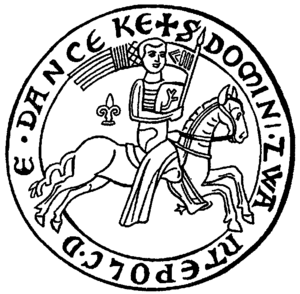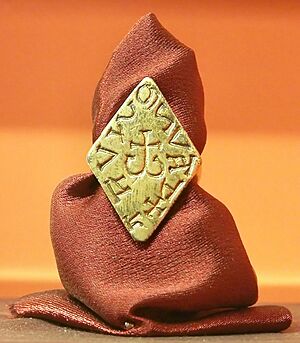Świętopełk II, Duke of Pomerania facts for kids
Quick facts for kids
Swietopelk II
|
|
|---|---|
| Duke of Pomerania | |

17th-century painting by Herman Han, Oliwa Abbey
|
|
| Born | c. 1195 |
| Died | 11 January 1266 |
| Buried | Oliwa Abbey |
| Noble family | Samborides |
| Spouse(s) | Eufrozyna of Greater Poland Ermengard of Schwerin |
| Father | Mestwin I, Duke of Pomerania |
| Mother | Swinisława |
Swietopelk II (born around 1195, died January 11, 1266) was an important ruler in the history of Pomerania. He was also known as Zwantepolc II or Swantopolk II. People sometimes called him the Great because of his achievements.
Swietopelk was the Duke of Pomerelia-Gdańsk. He ruled from 1215 until he died. He was the first ruler from his family, the Samborides, to call himself a "duke" starting in 1227.
Contents
What's in a Name?
Duke Swietopelk was known by many different spellings of his name. Some examples are Swantepolk, Svatopluk, and Świętopełk.
On official seals, his name often appeared as Dominus Zwantepolcus Dux Danceke. This means "Lord Zwantepolc, Duke of Gdańsk." Another common spelling was Svantopelc Ducis Pomeranie, meaning "Swantepolc, Duke of Pomerania."
Swietopelk's Early Life
Swietopelk was the son of Mestwin I. His mother's name was Swinisława. His father ruled Eastern Pomerania, also called Pomerelia, starting around 1205. He was given this role by the Polish high duke, Władysław III Spindleshanks.
In 1216 or 1217, Swietopelk became a steward of Pomerelia. This was a high position given to him by High Duke Leszek I the White of Kraków. Swietopelk was in charge of the Gdańsk area, which was the largest part of Pomerelia.
In 1218, Swietopelk took advantage of a local uprising. Knights were rebelling against Danish rule. Swietopelk used this chance to take over the Lands of Schlawe and Stolp. Later, his brother Warcislaw died without children. Swietopelk then took control of Warcislaw's lands in Lubiszewo Tczewskie.
When their father died, Swietopelk's younger brothers, Sambor and Racibor, were still young. Swietopelk became their guardian. As they grew up, his brothers received their own parts of the family lands. Sambor received Lubiszewo Tczewskie, and Racibor received Białogard.
Gaining Independence
Swietopelk wanted Pomerania to be independent from Poland. He saw that Poland was divided into smaller parts, which made it weaker. He made a deal with another Polish duke, Władysław Odonic. Swietopelk promised Władysław the throne of Kraków and Silesia. In return, Władysław would help Swietopelk remove Leszek and Henry I the Bearded from power.
On November 23, 1227, many Piast dukes met in Gąsawa. During this meeting, Leszek was killed in an ambush. Henry was also badly hurt. Swietopelk II was involved in this attack, and perhaps Władysław was too. This event helped Swietopelk gain more power and independence.
Crusades and Conflicts
In 1233 and 1234, Swietopelk II joined a crusading army. His brother Sambor was also with him. They joined other important leaders like Hermann Balk, Konrad I of Masovia, Henry the Bearded, and Władysław Odonic.
They went to Kwidzyn (Marienwerder) and helped rebuild its defenses for the Teutonic Order. After this, the crusaders fought against the pagan Prussians, called the Pomesanians. This battle happened near the River Sorge. The crusaders won, which helped them control more of southern Prussia.
In 1238, Swietopelk conquered the Duchy of Pomerania-Schlawe. These lands were important because they connected Pomerania to Gdańsk, Nakło, and Bydgoszcz. This conquest led to a war with Kujavia.
Swietopelk's brothers, Sambor and Racibor, were supposed to be under his rule for twenty years. But after twelve years, they refused to support him. This disagreement led to a civil war. Sambor and Racibor were forced out of their lands. They first sought help from their relatives in Greater Poland. Later, they found allies with the Teutonic Knights. The Teutonic Knights were a Christian military group fighting against the pagan Prussians.
There were also money problems between the Knights and Swietopelk. This led Swietopelk to make an unexpected alliance with the pagan Prussians. Swietopelk played a big part in the First Prussian Uprising, which began in 1242.
It was surprising that a Christian ruler like Swietopelk would team up with pagan Prussians against a religious group supported by the pope. Swietopelk had always been known as a supporter of the Roman Catholic Church.
The uprising did not succeed. A peace treaty was signed on November 24, 1248. A representative from the pope helped arrange the peace. Swietopelk had to give back the lands he took from his brothers. He also had to let the Teutonic Knights travel through his lands. He agreed to stop charging fees on ships using the Vistula river. Finally, he promised to stop helping the Prussians. He kept his promise and did not help the Prussians during their Great Uprising from 1260 to 1274.
Swietopelk's Family
Swietopelk ruled for 46 years, starting in 1220. He died in 1266. His sons, Mestwin II and Wartislaw II, inherited his lands.
Marriages
- Eufrozyna: Swietopelk married Eufrozyna in 1217 or 1218. She died in 1230. She was the daughter of Odon, a duke from Greater Poland.
- Ermengarda: Before 1252, Swietopelk married Ermengarda. She was the daughter of Henry I of Schwerin. She died after 1270.
Children
- Mestwin II (born around 1220, died 1294): He became the duke of Świecie and later Gdańsk.
- Wartislaw II (born around 1237, died 1271): He became the duke of Gdańsk.
- Euphemia (born around 1225, died 1270): She married Jaromar II, who was the prince of Rugia.
- John (born around 1230, died 1248): He died when he was young.
- Unknown daughter: She married a Count of Kevenberg.
Images for kids




